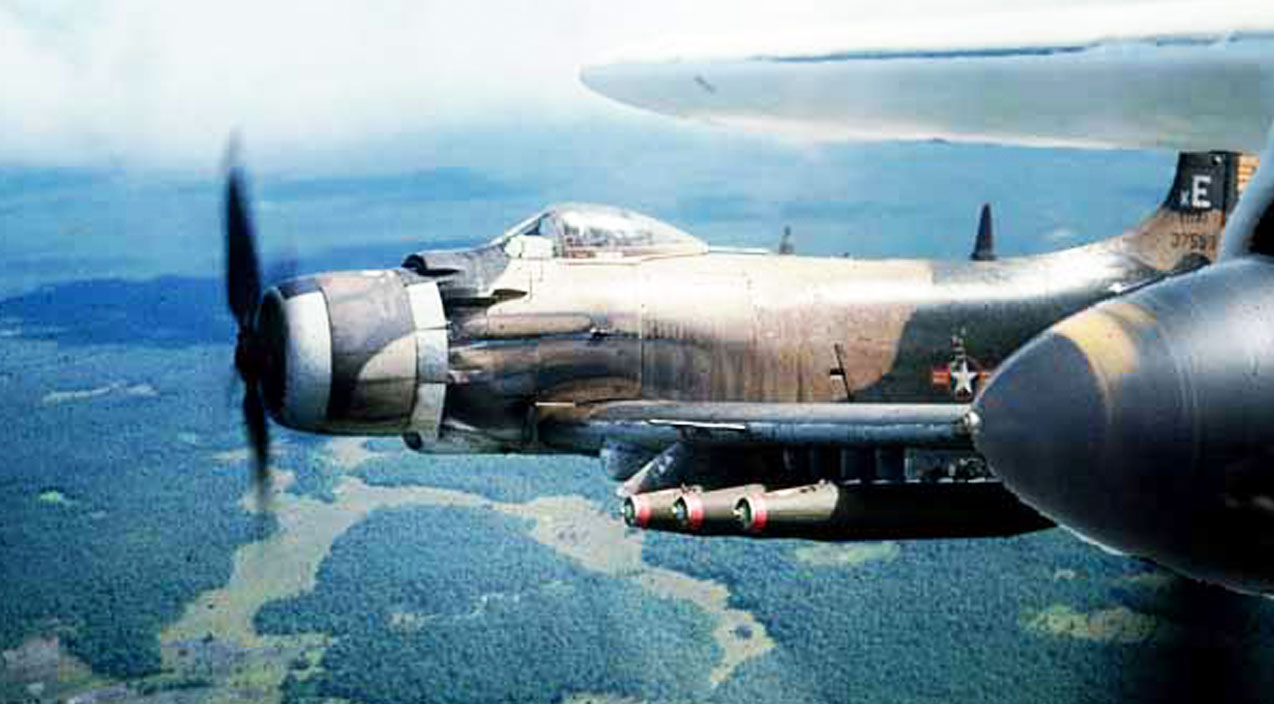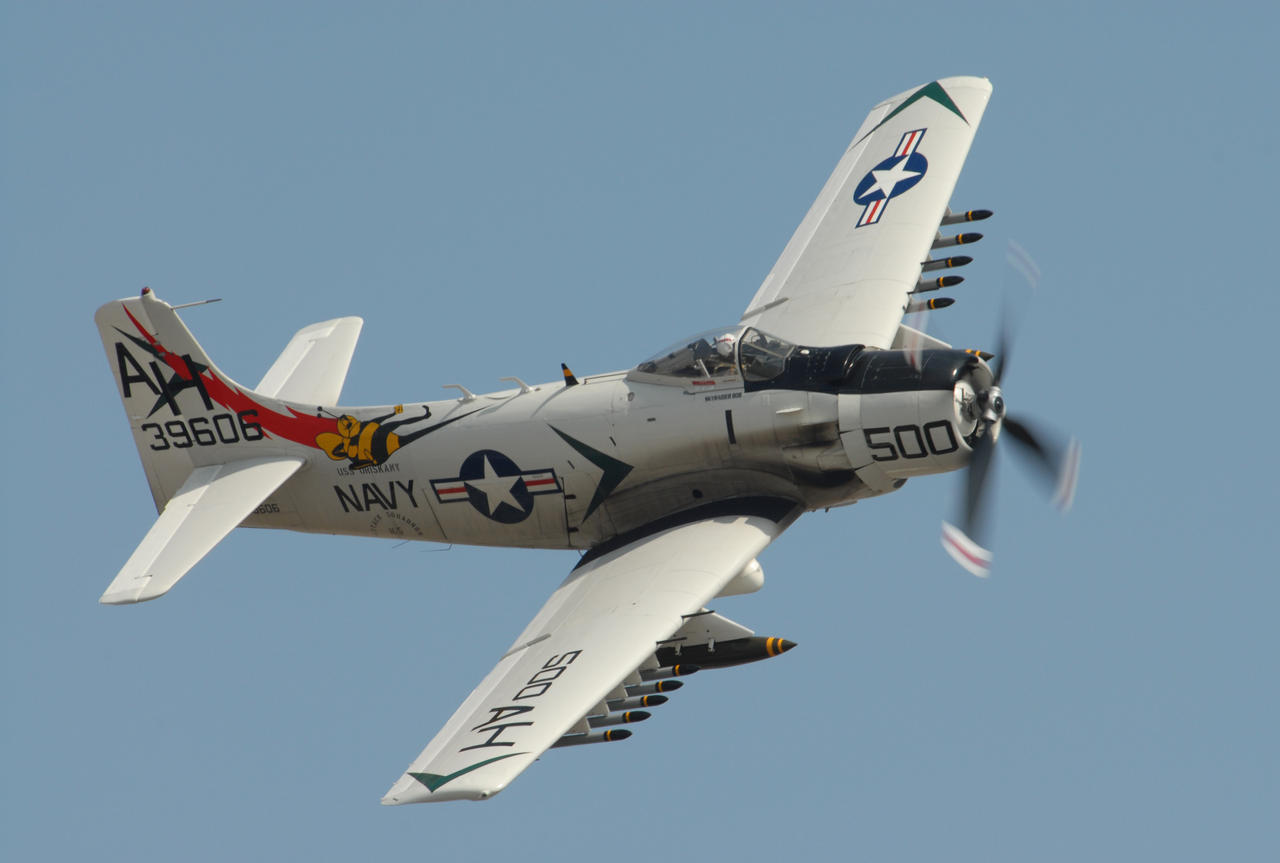Sandy Aircraft - The front page of Cold War shows this amazing photo taken by an A-1 Skyraider during Operation Sandy.
The A-1's 12 outer wings were capable of carrying 500-lb class stores. The two inboard stations (commonly called stubs) each hold 2000 pounds and the center station can handle equipment up to 3600 pounds.
Sandy Aircraft

Taken by former A-1 pilot Byron E. Hookey (see his website at Skyraider.org. 1st Special Operations Squadron during the Vietnam War) The main photo for this post is a Skyraider routine load on a Sandy mission. right
Douglas A 1 Skyraider
As Hookey himself explained in his book USAF and VNAF A-1 Skyraider Units of the Vietnam, the A-1's 12 outer wing stations were capable of carrying 500-lb class stores. The two inboard stations (commonly called stubs) each hold 2000 pounds and the center station can handle equipment up to 3600 pounds. Multiple Ejector Racks (MERs) can be installed at base stations to increase the number of loaded weapons. Weapons carried by USAF and VNAF Skyraiders can be divided into the following categories - guns, bombs, napalm, rockets, cluster bombs (CBUs) and miscellaneous stores.
The M3's four internal guns each carried 200 rounds of 20 mm ammunition. Arms are placed in pairs, internal and external. The rate of fire was 600-800 rounds per minute (10-14 rounds per second), meaning the weapon could be fired in ten seconds. There were two types of 20mm rounds commonly used in combat, the M95 Armor Piercing Tracer (APT) and the M97 High Explosive Detonator (HET). Cruising speed for both rounds was 2730 feet per second.
SUU-11 guns (known as miniguns) were also often carried at the base station. It was a six-barrel Gatling-type weapon rated at 6,000 rounds per minute (100 rounds per second). The minigun, which carried 1,500 rounds of 7.62 mm ammunition, was a very useful weapon during SAR operations to work around friendly forces or downed pilots.
The A-1 had three types of bombs - general purpose (GP) bombs, fragmentation bombs and white phosphorus (WP) bombs.
A 1 Skyraider Hi Res Stock Photography And Images
The early GP bombs used by the A-1s were left over from the Korean War and were actually left over from World War II. It was available in various sizes, and could be used in boxes or sharp boxes. The types of bombs commonly used on the A-1 are the M30 (100-lb), M57 (250-lb), M64 (500-lb), M117 (750-lb) and M66 (1000-lb).
US Air Force Douglas A-1H (formerly US Navy A-1H BuNo. 139609) named Bad News, 1969 ET. The aircraft is armed with six Mk 82 227 kg (500 lb) bombs. Including a "dice cutter" fuse and two. Mk 20 "Rocky" cluster bombs. A-1H 139609 was later transferred to the South Vietnamese Air Force, 518th Fighter Squadron, 23rd Tactical Wing, at Bien Hoa.
These relatively young, low-yield GP bombs were excellent for supporting friendly forces in close quarters attacks by enemy forces. Can be freely thrown against enemy troops within 100 feet of safe friendly troops.

An advanced family of GP bombs (known as low-drag GP or LDGP) was developed by the US Navy in the late 1960s. Designed for the Mark (Mk) 8X series, it was a major improvement over previous GP bombs. Available sizes were Mk 81 (250-lb), Mk 82 (500-lb), Mk 83 (1000-lb) and Mk 84 (2000-lb).
N449ma Hot Start Tbm \
All GP pumps require a fuse - usually a nose and tail fuse for reverse. The fuse was a weapon clock that expired at a certain time after release, allowing the aircraft to safely detonate. Daisy cutters (also known as Daisy Cutters) were often used to ensure that the bomb detonated before it was planted on soft ground. Skyraider pilots of the 1st ACS and 602nd Fighter Squadron Commando) pioneered the early use of 'daisy cutters'. Initially, the nose of the bomb had an inert barrel of a 20mm cannon attached which fed back into the bomb's fuse. Later, a metal tube was welded instead of a fuse. The problem with the spacers was that they often did not align with the axis of the pump, resulting in less accuracy.
These early efforts attracted the attention of weapons experts, before long production fuzes were used not only by A-1s, but also by all fighter and bomber forces of all services in Southeast Asia.
Early cluster bombs were used when targeting enemy forces. The M81 and M88 cluster bombs were 250-lb weapons that were essentially similar with slightly different designs. Their similarity allowed them to be presented in the same way. The most commonly used cluster bomb was the M1A cluster bomb. It consisted of a preformed cluster of 20 lb fragmentation bombs assembled into a cluster of six bombs. The M1A was used by A-1s of both services throughout the war.
The final member of the bomb family was the M47 100-lb WP weapon. The favorite flight of many USAF pilots, the A-1 was used in the early stages of the war as well as at the end. The bomb's white phosphorus filler, which burned at a higher temperature than napalm, exploded on impact when the weapon was fired. If dropped safely, the bomb will explode on impact and white phosphorous will emit tracer smoke in the air for over an hour.
B 24 The Goon Usaf Military Aircraft Vintage Magazine
Napalm was often used, consumed in 500- and 750-lb. The smaller of the two is carried on the A-1's outer wing bases, while the larger can only be carried on the inner bases. Earlier napalm stores were consolidated and moved to the base, but later versions were further removed from the base and prepared in ship-ready units. Once the weapon was attached to the aircraft, installing the fuse was all that was left. Napalm comes in fine and non-fine forms. The lowered 'cap' allowed for better accuracy, but limited the 'snap' style of the weapon. Since the Skyrider was more accurate due to its low speed, uncoated napalm was chosen due to its mass burning pattern.
The 6th SOS operated from Pleco and Da Nang Air Bases in 1968 and 1969. It was disbanded on November 15, 1969 and its aircraft were transferred to the South Vietnamese Air Force (VNAF).
The A-1 also regularly uses missiles, of which two types (regardless of the warhead) are suitable for aircraft. The most common was the 2.75-in FFAR (Folding Fin Aerial Rocket), which was always carried in a pod of seven or 19 tubes. The seven-tube missiles were LAU-59 and LAU-68, while the 19-tube missiles were LAU-19 and LAU-3. Missiles could be launched by a single seven-tube launcher, but they had to be fired in pairs from a 19-tube key (all the first rocket loads were single-shot).

Warheads for 2.75-in FFARs can be white phosphorus (WP or 'white pit'), high explosive (HE), high explosive anti-tank (HEAT) or flechette. The final ward contains approximately 2,500 stamped stamps that look like six-pointed nails with three circular wings instead of nail heads. Typically, an entire wing will be loaded with one type of warhead rather than a combination.
A 1e Skyraider > Hurlburt Field > Hurlburt Field Fact Sheets
Another, more unusual, type of missile was the 5-in High Velocity Space Rocket (HVAR), mounted on the outer wing base pylons. Therefore, a maximum of 12 loads can be carried in one module.
Cluster bomb units (CBUs) fired from Skyraiders were different from those used by jet aircraft. In 1964, William M. Maughan and his team at Hurlburt Field developed a new CBU dispenser specifically for the A-1, the SUU-14, in the first combat application group. Less than six feet long, it consists of six tubes arranged in a triangular shape held together by steel reinforcement. It differed from this launcher in that it was attached to the A-1 and the bombs were dropped from the rear.
The first CBU-14 missile to use the SUU-14 dispenser was the CBU-14, which worked well for outdoor targets but was not good enough for forested areas because the BLU-3 bomb would detonate over trees. which may be 100 feet or more. In addition to the enemy, the BLU-3 had a very high yield, and provided the enemy with anti-personnel weapons that could be used against friendly forces in the form of bombs.
Recognizing the need to improve the Skyraider's CBU armament, a second version was designed and produced in September 1970. Still using modern SUU-14 equipment, the CBU-25 carries 132 BLU-24 bombs (22 per.
Sandy Hook Students Get Chance To Smile At Sikorsky Airport
Sandy loam, sandy cove, sandy shores, sandy rentals, nissan sandy, florist sandy, sandy feldman, hyundai sandy, sandy flowers, sandy toyota, sandy sansing, homes sandy
0 Comments